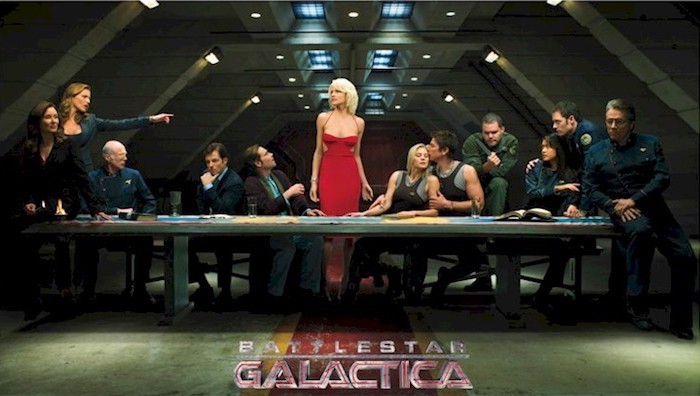
If you’ve read anything I’ve written here on Nieman Lab over the past five years, you’ve likely noticed I’m fond of slipping pop culture analogies — or wholesale imagery — into stories about the media business. Yes, it’s a crutch. But at least I admit I have a problem. Besides, I love TV and comics and I’m not ashamed of it. They’re my Rosetta Stone for trying to make sense of the changes that are going on in media.
Which is what brings me to Battlestar Galactica. There’s a scene in the 2003 miniseries that led to the revival of the 1970s sci-fi show that I regularly go back to because it feels connected to the state of journalism.
Some setup: Sexy robots vs. Edward James Olmos in space. Humanity is on the run, and two characters are at a crucial moment deciding whether they need to fight or flee. And then, one says:
I’m going to be straight with you here: The human race is about to be wiped out. We have 50,000 people left, and that’s it. Now, if we are even going to survive as a species, then we need to get the hell out of here and we need to start having babies.
Extinction-level events have more or less become the new normal in the news business. Think back to Craigslist, moving up to the scourge of content farms, the aggregator threat. And let’s not forget paywalls, native advertising, brogrammers, and, now, ad blockers.
Which is why you’d think journalism should have been wiped out by now. And yet it’s surprisingly resilient — and, under the right circumstances, profitable. But in order to reach whatever the hell the future looks like in this business, it’ll be necessary to step back from the #contentwars and start, well, building new things. Or, starting having babies.
Every minute spent debating whether bloggers are journalists, if Vice is really in the news business, if journalists need to learn code, and if viral traffic is bullshit is time not spent making something that might have the potential to connect with an audience, or even motivate them to open their wallets.
Which, of course, is why I’d like to ride into the sunset by firing off some burning hot takes on the state of the news business. Aside from being a talking head with a mustache, I’ve played on a softball team for the Harvard Business Review, which pretty much makes me an MBA. Prepare yourself for this burrito bowl of incisive media analysis. Call your lawyer, a priest, and that guy you know who plays in a kickball league with someone at Andreessen Horowitz.

There’s suddenly a lot of Scarface: The World is Yours-sized piles of money between investments in places like BuzzFeed, Vox Media, Vice, and Business Insider.
How worried should we be that all this money will collapse the budding online journalism economy? Is private investment only inflating media companies that are still scrambling to find a foothold in a quickly shifting advertising environment? Is it creating a system of have and have nots, where the only way to survive is to reach broad audiences across a variety of verticals that also position you for an over-the-top offering on the synergistic telecom company that is snuggling up for global strategic planning?
SHUT UP AND TAKE THE MONEY before Elon Musk triggers The Singularity.

Speaking of omnipresent corporations that control vast amounts of power and probably a doomsday machine or two, let’s talk about moving pictures on screens. You know what’s going to be huge very soon? Video.
At this point, I’m certain the people who keep saying video is the future are also responsible for selling us all on Dippin’ Dots as the ice cream of the future. Because dessert in pellet form is the ultimate in snackable content.
First it was raw video shot by newsrooms. Then it was video shot by your “one-man band” and his/her multimedia bug-out/burn-out bag. Actually, strike that. Hosted, newscast-style video segments shot inside your newsroom is actually the next big thing.
Everyone is trying to chase the (legal) high that is video ad dollars. Because when you’re counting digital dimes and pennies, nice fat prerolls from Ford or Taco Town are salvation.
Should you be staffing up your own Motion Pictures unit? Absolutely. Do you need to get on YouTube Gold Club Elite? Probably. Now that you’ve got cartoon bags of money lying around, spend it on green screens and craft services, and “the talent.” How else can you double-down and gain that sweet ad cash for your investigative travelogue series on animal husbandry? Frankie Muniz’s people are already onboard.
That may not stop those millennials you’re hunting from watching most of their content on Vine, Instagram, or Snapchat.

Listen, I like snake people as much as the next guy. Some of my favorite former coworkers are millennials. And sure, once you get over the fact that your Diff’rent Strokes references hold no water and that they have questionable eating habits, they’re not entirely terrible human beings.
But do they really, really need entire swaths of the Internet dedicated to millennial-focused content initiatives? Have we learned nothing from the crimes of Kidz Bop?
Journalism’s unhealthy lust for the young rivals only Hollywood’s in its vigor and persistence. As someone who was a one-time “youth columnist” for a newspaper, I assure you stories on skate parks and Tamagotchi will not trick them into subscribing to anything.
Millennials, like most human beings, probably just want a delicious mix of information that crosses their interests, surprises them, and fits into their daily habits in comfortable ways. Much like a Tamagotchi.

How many more indicators does the media business need that it should be hiring more brown people, queer people, transgender people, young people, or women people? Here is a basic question: Does your operation in any way resemble the audience you are trying to reach? Oh, it looks like Roger Sterling’s garden party? Interesting.
Making newsrooms more inclusive isn’t about creating a representative democracy of personal identities. “Yes, you there, 24-year-old Jewish lesbian who grew up in Ames, Iowa? What do you people want from us?” Creating that newsroom is about increasing the variety of voices that will inform stories and create projects that could expand your audience. It’s also, about staying competitive with your peers. Those young, hungry staffers who scare you are looking for paths to the future in your company.
It reminds me of a passage from our holiest of scriptures in media, The New York Times innovation report:
We rarely hire outsiders directly into leadership positions. We have struggled to groom our digital journalists for leadership, in part because we don’t fully know how to use their skills. And we have a tendency to move traditional journalists into top digital roles.
Take the time. Take the risk on a candidate that doesn’t meet whatever idealized vision you had in your head for a position. If they don’t have all the qualifications, that just makes them more hungry. If they make you uncomfortable, even better. The only people who should obsess over “fit” are Tim Gunn and Heidi Klum.
Listen, since we’re all going to be working for Stacy-Marie Ishmael or Lydia Polgreen at some point anyway, you’ve got nothing to lose.
Not everything can be solved by the Times’ Innovation Report. Sorry.
For that matter, there’s not a lot that can be solved by imitating what the Times does. Or any other Major Media Brand. Welcome to my seminar on Media Nihilism and The Infinite Sadness.
When you write about media companies over an extended period of time, you see when trends take hold and suddenly everyone in school is now wearing Lululemon yoga pants and L.L. Bean duck boots. Or, in this case, developing sponsored content, events businesses, and membership programs.
The days of successfully running a media company by playing follow the leader are officially over. Realistically, how many media companies are going to come up with a strategy for messaging apps, or devote time to understanding them? How many have the ad staff necessary to program sponsorships for a newsletter or podcast over the next six months? If we’re honest, there are maybe five companies capable of operating remote drone bases for targeted news insertion strikes.
Does this mean you should stop reading Nieman Lab and change your out of office responder to ¯\_(ツ)_/¯?
Of course not. Instead, pick and chose the things that seem like they could apply to your specific corner of the media universe. Think of it as a Choose Your Own Adventure, but with more wearables.
Now, with all of that settled, my heart can be at rest as I say a farewell to #content. Thanks again to Josh, Laura, Yossi, and Shan. And Fuego, I think I’ll miss you most of all.
If there’s another thing I come back to — other than quotes about fighting robots and making babies in space — it’s the things David Carr would say and write. In 2013, he told Ken Doctor: “I like that people pay attention to what I write, but I never get confused about the fact that if my last name were not New York Times, far fewer would care what I thought.”
Thanks for reading, and for putting up with me, for five years. I’m pretty sure this journalism thing is going to work itself out.
Justin Ellis was a staff writer at Nieman Lab for five years. He is now a senior editor for ESPN The Magazine.